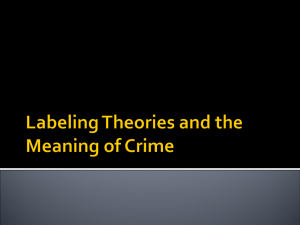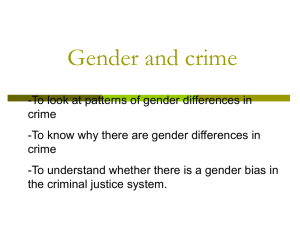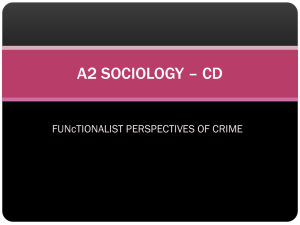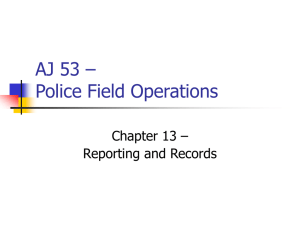unit_4_crime_gender
advertisement
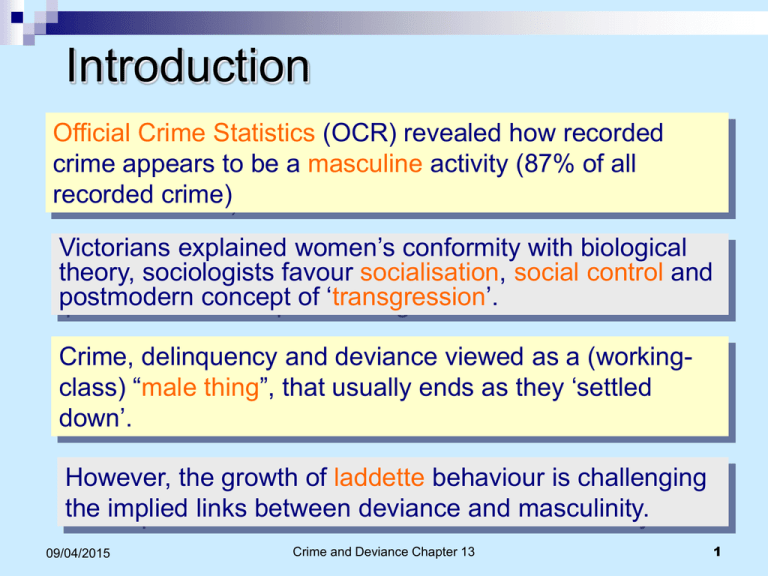
Introduction Official Crime Statistics (OCR) revealed how recorded crime appears to be a masculine activity (87% of all recorded crime) Victorians explained women’s conformity with biological theory, sociologists favour socialisation, social control and postmodern concept of ‘transgression’. Crime, delinquency and deviance viewed as a (workingclass) “male thing”, that usually ends as they ‘settled down’. However, the growth of laddette behaviour is challenging the implied links between deviance and masculinity. 09/04/2015 Crime and Deviance Chapter 13 1 Gender and Crime 3 questions we need to address in order to ascertain if women are less criminal than men: Is there any Are there evidence that differences in the women’s crime has kinds of crime changed in either committed by men amount or and women? kind ? http://www.youtube.com/watch? v=gGGXUkOQIng&feature=fvsr http://www.youtube.com/watch? v=UvHE86XsC0M 2 Crime and Deviance Chapter 13 Are there differences in the amount of crime committed by men and women? 09/04/2015 Female Crime Statistics Whilst they commit less than men, women commit all types of offences. Women’s property crime is motivated by economic factors (just like men). Women fear and feel the impact of the stigma of the ‘criminal’ label. Quantitative and qualitative evidence suggests: 09/04/2015 Women offenders are seen as 'doubly deviant' - for breaking social rules, and being viewed as ‘unfeminine’. Crime and Deviance Chapter 13 3 ‘Chivalry’ Factor Some argue women are more deviant than they appear and are protected by a ‘chivalry factor‘ by police, courts, etc. Hilary Allen (1987) argues mental health explanation (including PMS) for female criminality results in lighter punishments by the courts. However, Eileen Leonard (1982) challenges the 'chivalry factor‘ pointing out how ‘bad women’ are treated more harshly than some men. 09/04/2015 Crime and Deviance Chapter 13 4 Theories of Gender and Crime Frances Heidensohn (1985) suggests that the question we should be asking is not why some women commit crime, but why women are so non-criminal? She considers three explanations: Biological Theory 09/04/2015 Sex-role Theory Crime and Deviance Chapter 13 Transgression 5 Biological Theory The origins of this theory go back to Victorian ideas such as Cesare Lombroso (left). It argues that 'normal' females have a disposition that repels them from deviant and criminal behaviour. This theory has little support in sociology, although a link between female crime and hormonal and menstrual factors has been made. 09/04/2015 Crime and Deviance Chapter 13 6 Pat Carlen and Control Theory Frances Heidensohn argues most women conform because failure to do results in labelling as unfeminine behaviour. Pat Carlen (1985) has adopted control theory located in 'class deals' and 'gender deals'. Females who are most likely to become criminal are those who have not had, or have rejected, the 'gender deal'. Females who have been in care, thrown out of home, or have rejected 'normal' family life, are the most likely to be lawbreakers. 09/04/2015 Crime and Deviance Chapter 13 7 Sex-role Theory (Socialization) From infancy, children are socialized that the two sexes are different. Female rôles contain such elements as caring, passivity, and domesticity. Male rôles, on the other hand, stress elements of toughness, aggressiveness and sexual conquest. It is argued that females generally lack the values that are typically associated with delinquency. However, laddette behaviour challenges this. 09/04/2015 Crime and Deviance Chapter 13 8 Sex-role Theory (continued) Even with shoplifting and prostitution it is argued these express socialised roles of family provider on the one hand and sexual provider on the other. 09/04/2015 Crime and Deviance Chapter 13 9 Social Control Frances Heidensohn (1985) says women commit so few crimes because of the ways in which they are ideologically controlled. Firstly in the way in which societies are cemented together by a shared value system. Secondly in the way bonding occurs within relationships of family, the peer group, and the school. 09/04/2015 Crime and Deviance Chapter 13 10 Lack of Opportunities There was an assumption that because women were confined to the private world with limited access to the public world they lacked opportunity for crime. However, this situation is changing, with women occupying roles in the workplace and public life. Women still have less opportunity for crimes but Wilkinson found in California that where women were equal to men, they were engaged in similar levels of white-collar crime. 09/04/2015 Crime and Deviance Chapter 13 11 Transgression Adopting a Postmodernist approach Carol Smart (1990) introduced the concept of 'transgressive criminology‘. In order to understand crime in a Postmodernist society, transgression takes us beyond the boundaries of conventional criminology. It considers ideas as diverse as selfimposed curfews; treatment of women as victims; domestic violence, abuse and rape. 09/04/2015 Crime and Deviance Chapter 13 12 Patterns and Trends in Crime according to Gender Suggest patterns in relation to: Male vs female offenders in OCR statistics Types of crimes committed by males/females Reasons for committing crime Male vs female victims 09/04/2015 Crime and Deviance Chapter 13 13 These are the recent patterns According to OCR 2006 87% of offenders are male although this may have changed Women rarely commit violent crime most are convicted of theft type crimes. Pat Carlen’s Sex-role theory suggests women commit crimes for different reasons, usually to provide for their families. Statistically males are more likely to be victims, however Feminists argue crimes against women are under –represented in the statistics. 14 Crime and Deviance Chapter 13 09/04/2015 James Messerschmidt James Messerschmidt (1993, pictured left) argues there is a 'normative masculinity' (what a real man should be), highly valued by most men. He argues that masculinity is something males have to constantly work at. A businessman can achieve masculinity through the exercise of power over women in the workplace, whereas a man with no power at work may express his masculinity through control of women in the domestic situation – e.g. domestic violence. 09/04/2015 Crime and Deviance Chapter 13 15 Messerschmidt: Middle-class Males Middle-class boys achieve educational success but at the expense of emasculation. In school they adopt an 'accommodating masculinity', But compensate for this out of school by adopting a more 'oppositional masculinity': engaging in pranks, excessive drinking and 'high spirits'. 09/04/2015 Crime and Deviance Chapter 13 16 Messerschmidt: Working-class Males Working-class males adopt an 'oppositional masculinity', both inside and outside school, which is more aggressive in nature. Young Black males can be sucked into property and violent crime as ways of enhancing 'hegemonic masculinity‘ (Bob Connell). Messerschmidt notes how rape and pimping is sometimes used to express control over women. 09/04/2015 Crime and Deviance Chapter 13 17 Aggressive Masculinity Men may express their masculinity through criminal behaviour, e.g. fighting, football hooliganism, etc. Bea Campbell (1993) argues young men seek compensation for lack of breadwinner status through 'aggressive masculinity'. The forms of masculinity adopted involve control over technology (stolen cars) over public space (the streets); violence against the 'other' (Asian shopkeepers and women). 09/04/2015 Crime and Deviance Chapter 13 18 Enjoyment of Deviance Katz (1988) argues that criminology has failed to understand the role of pleasure in committing crime. This search for pleasure is meaningful when equated within masculinity’s stress upon status, control over others, and success. Violent crime is 'seductive' undertaken for chaos, thrill and potential danger. AO2 Point: Compare to Postmodernist search for thrills and to Walter B. Miller’s focal concern of ‘excitement’. 09/04/2015 Crime and Deviance Chapter 13 19 Summary Questions Explain how these terms are used to explain male crime. Normative masculinity Emasculation Accommodating / oppositional masculinity Crime as seductive/for excitement 09/04/2015 Crime and Deviance Chapter 13 20 Will Women’s Crime Rise? Freda Adler (1975) believes that women’s liberation will increase women’s participation in criminal activity. Evidence of recent rises in youth offending of girls. Youth Justice Board found 25% increase from 2003 to 2006. Just as they are penetrating the labour market, so they are moving also into ‘criminal careers’. However, Carol Smart (1979) criticises Adler on the grounds that she (wrongly) sees juvenile delinquency as reflective of future adult crime. 09/04/2015 Crime and Deviance Chapter 13 21 Rise in Women’s Crime Stephen Box feels that any increase in women’s property crime has more to do with poverty (especially as lone-parents) than their liberation. He also found a relationship between the increasing employment of women police officers and the recording of violent crime by women. He suggests the authorities have also been ‘sensitized’, resulting in female crimes of violence becoming more likely to be recorded. 09/04/2015 Crime and Deviance Chapter 13 22 Independent research. Recent stories about female crime or specific crimes involving female offenders Use the link below to look at a podology article. http://www.podology.org.uk/#/increasingfemale-crime/4541864496 09/04/2015 Crime and Deviance Chapter 13 23 Answer the following Idenitify at least three reasons why female crime might be increasing Identify the types of crimes that are increasingly being committed by females Identify research studies or statistical evidence which supports these claims 09/04/2015 Crime and Deviance Chapter 13 24 Presentation task Create a ppt presentation which covers the main issues related to gender and crime. 1. Patterns and Trends 2. Feminist views 3. Masculinity and crime 4. Rise in female crime You should include research evidence and statistics and examples of news stories. Upload your presentation to the blog by Thursday end of school. 09/04/2015 Crime and Deviance Chapter 13 25

